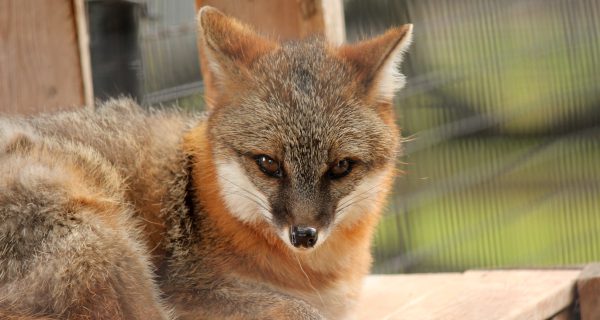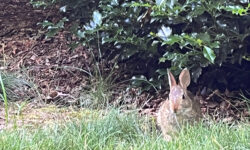The gray fox's face is flatter, and could perhaps be described as more feline than that of a red fox.
By Stephen Press
Hometown Weekly Editor
The yips grew closer and closer. Two distinct individuals could be discerned, as though they were in conversation. As there was a full moon, my brother Andrew and I decided to step out to the back porch for a look - perhaps we might be lucky to spot something; if nothing else, we'd hear the yipping a bit more clearly. Out we went into the late-winter night, bundled and wholly unaware of what was to dart from the woods.
When one discusses foxes in conversation, an immediate image is conjured: that of a red-orange canid with a bushy tail, perhaps stalking outside of a henhouse, using its advanced wits to outsmart its woodland neighbors. There are, of course, plenty of these gorgeous mammals running around in our woods, backyards, and (often regrettably) farms; an early morning drive through the rural routes of Hometown Weekly's communities might even reveal one or two along the side of the road, or perhaps stalking through a meadow. They are entirely striking.
It's not these foxes that I'm addressing, though. Besides the ubiquitous red fox, there's another that calls this area home, and it's among the more fascinating animals of New England: the gray fox.
Compared to its red relatives, the gray sports a number of major physical differences. Firstly, as indicated by its name, it is not blessed with the sumptuous coat of its flashier neighbors. Rather, it sports a silvery back, framed by rusty red with a white underbelly. A black stripe runs along the top of its tail, ending in a prominent tip at the end. Its face is flatter and could perhaps be described as more feline in nature - whereas the red fox’s muzzle immediately recalls that of a dog or wolf, the gray’s seems almost in between species. Grays are also smaller and stockier in size.
The animal "conversation" neared. We could now clearly hear rustling in the woods as the sources of the noises grew closer: snapping twigs, the occasional guttural growl, the odd yip or two. The moon reflected on the partially-melted snow below us. We hoped that whatever was out there would make an appearance on the grand, well-lit backyard stage. We watched and waited.
Part of what makes the gray fox so fascinating is that it's the most basal of canid species - that is, it's most closely related, evolutionarily speaking, to the ancestral species that ultimately spawned all dogs, wolves, and foxes. In that sense, watching a gray fox is akin to stepping into a time capsule. Long before Biscuit, Lexi and Phoebe climbed on your couch - before dogs as we know them even existed - gray foxes were climbing trees (they remain the only canid species in the Western hemisphere to do so) in the forests of the mid-Pliocene. To see one is to catch a glimpse of evolution in action, not to mention a picture of old New England, before extensive urban development - the gray once outnumbered the red fox in this area, before humanity altered the landscape. Nowadays? Red foxes, it turns out, are more adaptable to human presence and have thusly proliferated alongside settlers. Beyond that, grays do not tolerate reds in their territory. Those two factors make the gray a bit shy around us and our communities - while they are by no means endangered, they tend to be seen far more infrequently. To that end, if you see a fox, chances are it’s of the “central casting” red variety.
The noises were no longer "out there," but "right here." We stared over the grounds with bated breath. Then, they appeared out of the trees: two gray foxes, pursuing one another in full sprint, tore through, skidding on the old snow as they went. We were not prepared; Andrew, normally so staid and unflappable, reached out and grasped my jacket in complete thrall of the moment. Neither of us had ever seen a gray fox before, and we'd just seen two, in what we assumed to be a mating pursuit. It took a minute to gather ourselves as we listened to the chase continuing into the forest, and away from our perch.
Gray foxes are typically solitary creatures, only socializing when raising a litter or during mating season (which occurs from January through the end of March). They’re also generally quiet, the exception again being in mating season, during which time bonded pairs may communicate with a series of yips and barks. The litter arrives in early spring, with females sometimes taking advantage of their arboreal nature to give birth in hollowed-out cavities of large trees. By the time the kits are old enough to fend for themselves, their mother chases them off, forcing them to find territories of their own.
We put on our boots the next morning and had a look at the snow, hoping to confirm our sighting before the warming temperatures erased all evidence of the chase. We had not imagined it. Multiple clear paw prints told the story: we'd lucked out and seen the elusive gray fox. We recounted the tale over breakfast, still stunned at what we'd seen. It had been over three decades, filled with Audubon camps, walks in the woods, and endless hours looking out the back window, and we’d never seen one.
Sometimes, answering the call of the wild means watching and waiting for a moment that never comes. Sometimes, it means seeing something you'd never seen before. Whatever the outcome, when the sun sets over New England and its forests start talking, I’ve found that it's usually worth listening.























